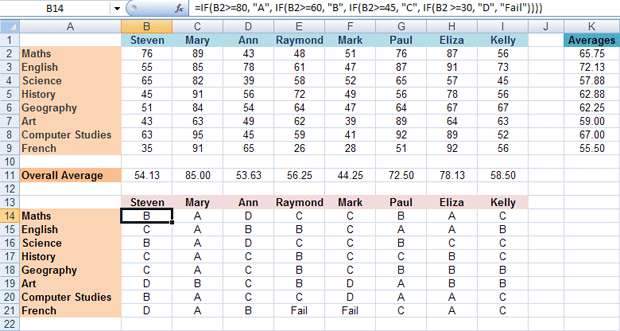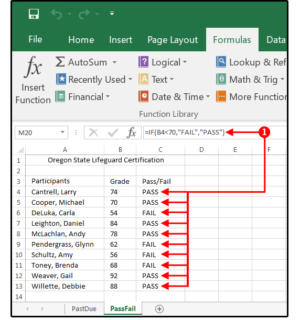The smart Trick of Excel If Statement With Text That Nobody is Talking About
The function tells the spreadsheet the sort of formula. If a mathematics feature is being carried out, the math formula is bordered in parentheses. Using the range of cells for a formula. As an example, A 1: A 10 is cells A 1 with A 10. Formulas are created making use of absolute cell recommendation.

In our very first formula got in right into the cell "D 1," we manually go into a =sum formula to include 1 +2 (in cells A 1 and also B 2) to get the overall of "3." With the next example, we utilize the highlight cells A 2 to D 2 and after that as opposed to keying the formula utilize the formula button in Excel to instantly develop the formula.
Lastly, we manually enter a times (*) formula utilizing amount feature to locate the value of 5 * 100. Keep in mind The functions provided below might not be the very same in all languages of Microsoft Excel. All these instances are performed in the English variation of Microsoft Excel. Tip The instances listed below are detailed in alphabetical order, if you wish to start with one of the most common formula, we suggest beginning with the =AMOUNT formula.

=STANDARD(X: X) Display the ordinary amount between cells. As an example, if you intended to get the average for cells A 1 to A 30, you would certainly type: =AVERAGE(A 1: A 30). =MATTER(X: X) =COUNTA(X: X) Count the number of cells in an array which contain any kind of message (message as well as numbers, not just numbers) as well as are not empty.
Excel If Then Statements - An Overview
If seven cells were empty, the number "13" would be returned. =COUNTIF(X: X,"*") Count the cells that have a certain value. For example, if you have =COUNTIF(A 1: A 10,"EXAMINATION") in cell A 11, then any type of cell between A 1 with A 10 that has the word "test" will certainly be counted as one.
For instance, the formula =IF(A 1="","SPACE","NOT SPACE") makes any type of cell besides A 1 say "SPACE" if A 1 had absolutely nothing within it. If A 1 is not empty, the various other cells will check out "NOT BLANK". The IF declaration has a lot more intricate uses, yet can usually be decreased to the above structure.
As an example, you might be separating the worths in between 2 cells. However, if there is nothing in the cells you would certainly get the =INDIRECT("A"&"2") Returns a recommendation specified by a message string. In the above example, the formula would return the value of the cell contained in A 2.
=MEDIAN(A 1: A 7) Discover the average of the worths of cells A 1 with A 7. As an example, four is the average for 1, 2, 3, 4, 5, 6, 7. =MIN/MAX(X: X) Minutes and Max stand for the minimum or optimum amount in the cells. As an example, if you intended to get the minimal value in between cells A 1 as well as A 30 you would certainly put =MIN(A 1: A 30) or if you intended to obtain the optimum concerning =MAX(A 1: A 30).
The Best Guide To Excel If
For instance, =Item(A 1: A 30) would certainly numerous all cells together, so A 1 * A 2 * A 3, and so on =RAND() Generates an arbitrary number above absolutely no however less than one. For instance, "0.681359187" might be an arbitrarily produced number placed right into the cell of the formula. =RANDBETWEEN(1,100) Generate an arbitrary number between two worths.
=ROUND(X, Y) Round a number to a particular variety of decimal areas. X is the Excel cell having the number to be rounded. Y is the variety of decimal locations to round. Below are some instances. =ROUND(A 2,2) Beats the number in cell A 2 to one decimal place. If the number is 4.7369, the above example would round that number to 4.74.
=ROUND(A 2,0) Beats the number in cell A 2 to absolutely no decimal places, or the nearest digit. If the number is 4.736, the above example would certainly round that number to 5. If the number is 4.367, it would certainly round to 4. =AMOUNT(X: X) One of the most frequently utilized feature to include, subtract, numerous, or divide worths in cells.
=AMOUNT(A 1+A 2) Add the cells A 1 and A 2. =SUM(A 1: A 5) Include cells A 1 with A 5. =SUM(A 1, A 2, A 5) Adds cells A 1, A 2, and also A 5. =SUM(A 2-A 1) Subtract cell A 1 from A 2. =SUM(A 1 * A 2) Multiply cells A 1 as well as A 2.

See This Report on Excel If Then
=SUMIF(X: X,"*"X: X) Do the SUM function just if there is a specified worth in the first picked cells. An instance of this would certainly be =SUMIF(A 1: A 6,"EXAMINATION", B 1: B 6) which just includes the values B 1: B 6 if words "test" was put somewhere in between A 1: A 6. So if you put EXAMINATION (not situation sensitive) in A 1, yet had numbers in B 1 through B 6, it would just add the value in B 1 due to the fact that TEST remains in A 1.

=TODAY() Would certainly publish out the current date in the cell gotten in. The worth will alter each time you open your spread sheet, to reflect the existing day as well as time. If you wish to go into a day that does not change, hold back semicolon) to enter the day. =PATTERN(X: X) To locate the usual value of cell.
=VLOOKUP(X, X: X, X, X) The lookup, hlookup, or vlookup formula allows you to look and also find related worths for returned outcomes. See our lookup definition for a full interpretation and also full details on this formula. .
Each IF function in an Excel spread sheet returns a couple of messages. The initial-- the "if" message-- displays if cells meet criteria that you define. The 2nd-- the "otherwise" message-- shows if they do not. For instance, mean that your sheet tracks the hrs that each of your workers works.
excel if formula using be excel formula if greater than zero if formula excel between two dates